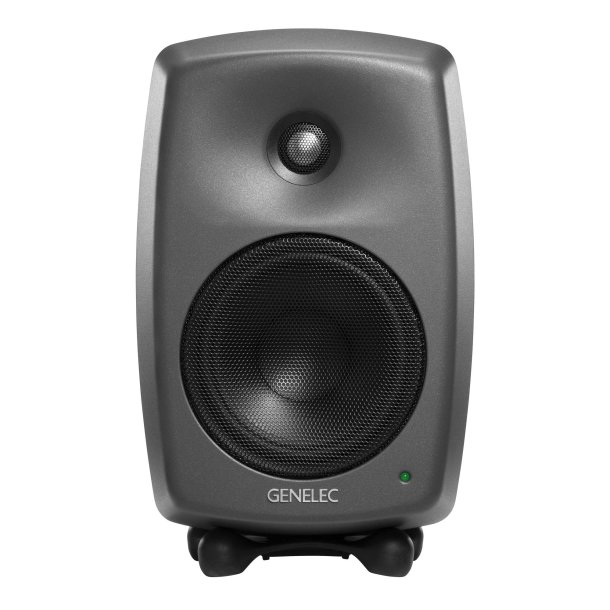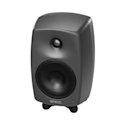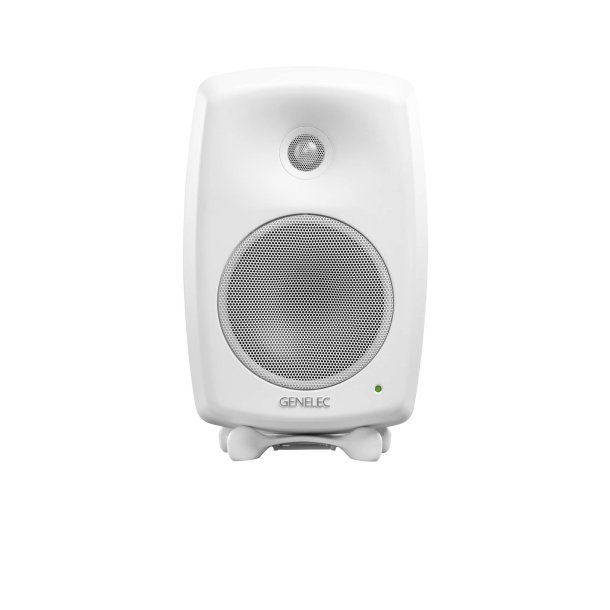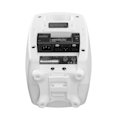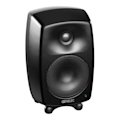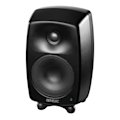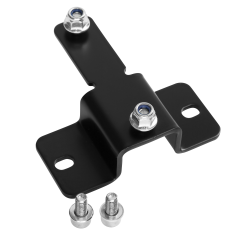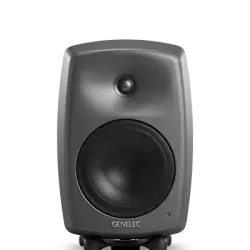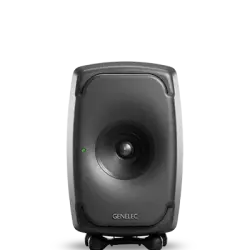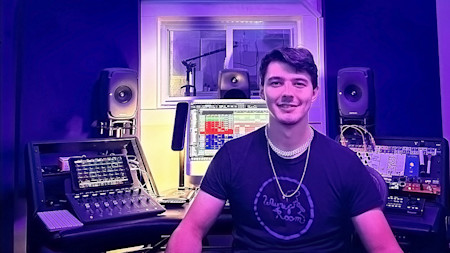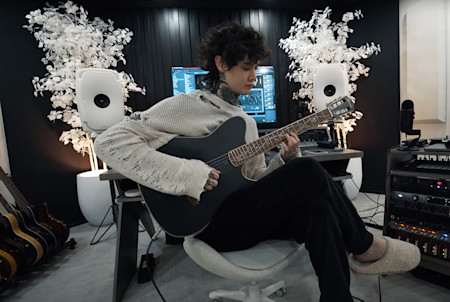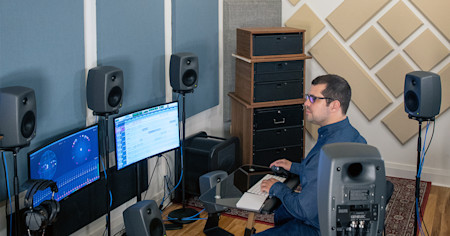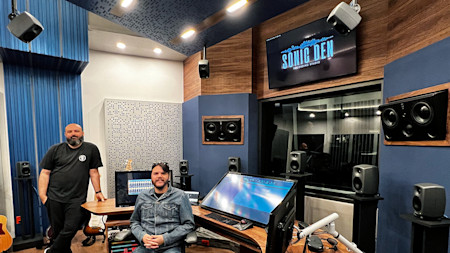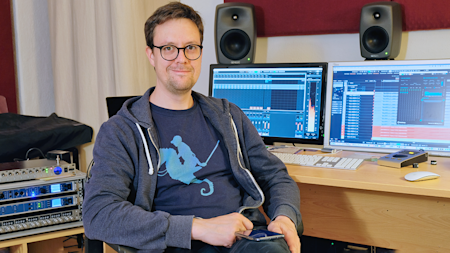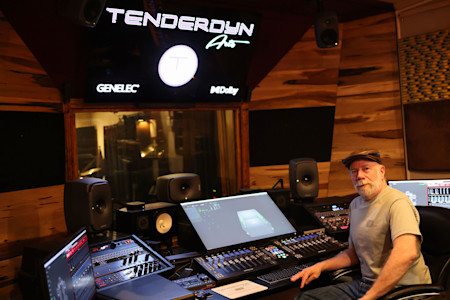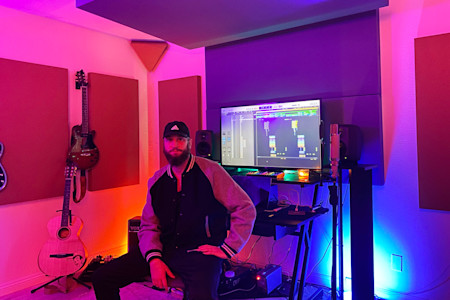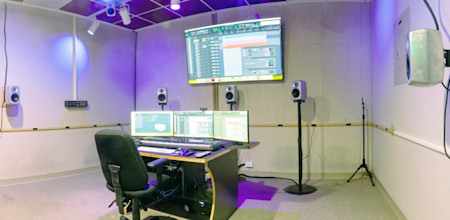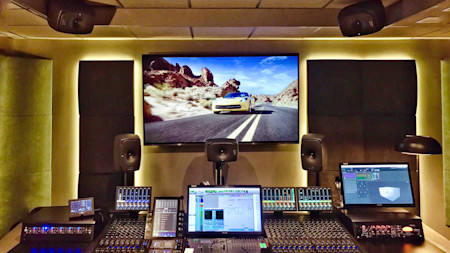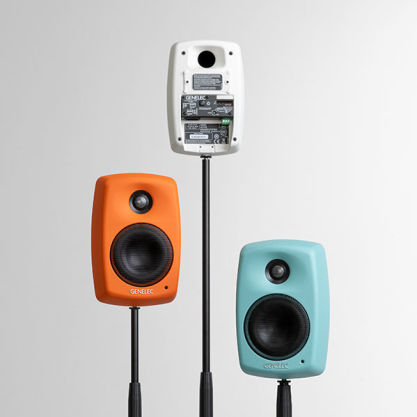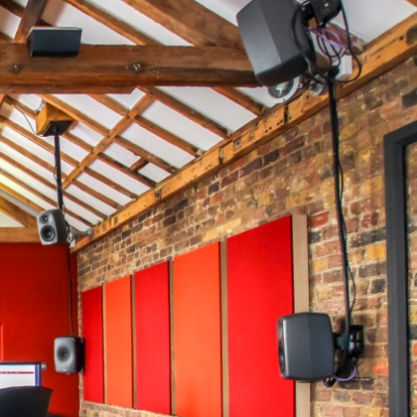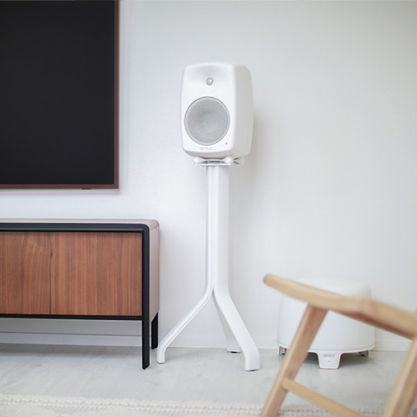Monitor activo inteligente de 2 vías con entrada de audio analógico balanceada y entrada digital AES/EBU, de tamaño compacto, incorpora procesamiento digital para autocalibración con GLM. Incluye base de desacoplamiento Iso-Pod.
8330A
Monitor de referencia SAM™

Smart Active Monitoring (SAM™) and GLM™ calibration technology

Directivity Control Waveguide (DCW™) Technology

SPL
104 dB

Respuesta en frecuencia
45 Hz - 23 kHz (-6 dB)

Dimensiones
H 299 x W 189 x D 178 mm, con Iso-Pod™ (ver en pulgadas)

La elección de los profesionales
La elección de los profesionales exigentes, para quienes la potencia y la flexibilidad van de la mano, el 8330A ofrece un poco más de SPL y extensión en baja frecuencia que su hermano menor 8320A. Al proporcionar una reproducción transparente y veraz, con su área de escucha amplia y sin coloración, el 8330A permite tomar decisiones de mezcla precisas y confiables.
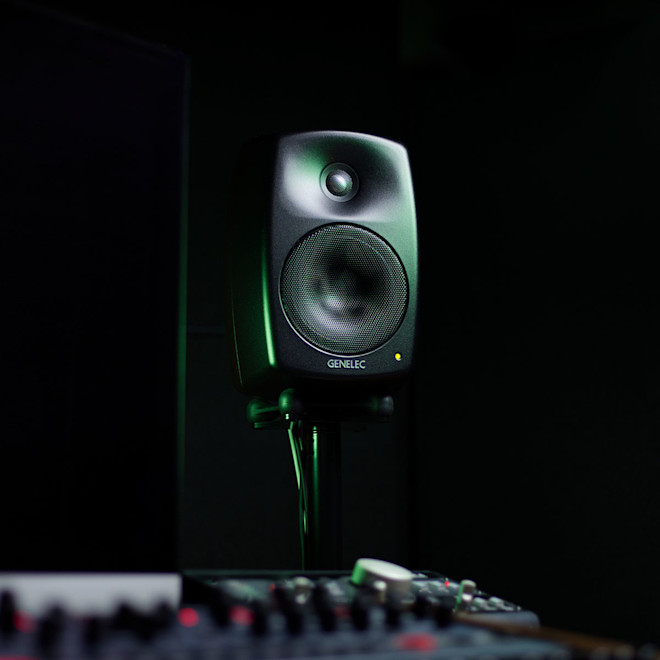
Monitoreo realmente optimizado
Como monitor activo inteligente, el 8330A se integra perfectamente con nuestro software GLM, a través del cual puede configurarse y calibrarse para adaptarse a su entorno de escucha, compensando el impacto acústico de la interacción con la sala para crear una solución de monitoreo verdaderamente optimizada desde sistemas mono a inmersivos. Ya sea que trabaje en espacios acústicos desafiantes o necesite una solución móvil que pueda adaptarse rápidamente a diferentes salas, el 8330A es su compañero de monitoreo compacto e inteligente.
8330A
Premios
Especificaciones técnicas

SPL
104 dB

Potencia del amplificador
50 W Bass (Class D) + 50 W Treble (Class D)

Respuesta en frecuencia
45 Hz - 23 kHz ("-6 dB")

Precisión de la respuesta en frecuencia
± 1.5 dB (58 Hz - 20 kHz)

Dimensiones del altavoz
⌀ 130 mm Bass + ⌀ 19 mm Treble (ver en pulgadas)

Dimensiones
H 299 x W 189 x D 178 mm, con Iso-Pod™ (ver en pulgadas)

Peso
5.1 kg / 11.2 lb

Conexiones
1 x XLR Analog Input
1 x XLR AES/EBU Input
1 x XLR AES/EBU Output
2 x RJ45 Control
8330A
Monitor de referencia SAM™
Especificaciones técnicas
Monitor activo inteligente de 2 vías con entrada de audio analógico balanceada y entrada digital AES/EBU, de tamaño compacto, incorpora procesamiento digital para autocalibración con GLM. Incluye base de desacoplamiento Iso-Pod.
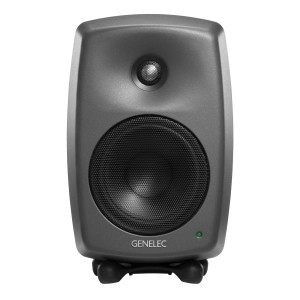
Especificaciones del sistema
Respuesta en frecuencia
58 Hz - 20 kHz (± 1.5 dB)
Corte de graves -6 dB
45 Hz
Corte de agudos -6 dB
23 kHz
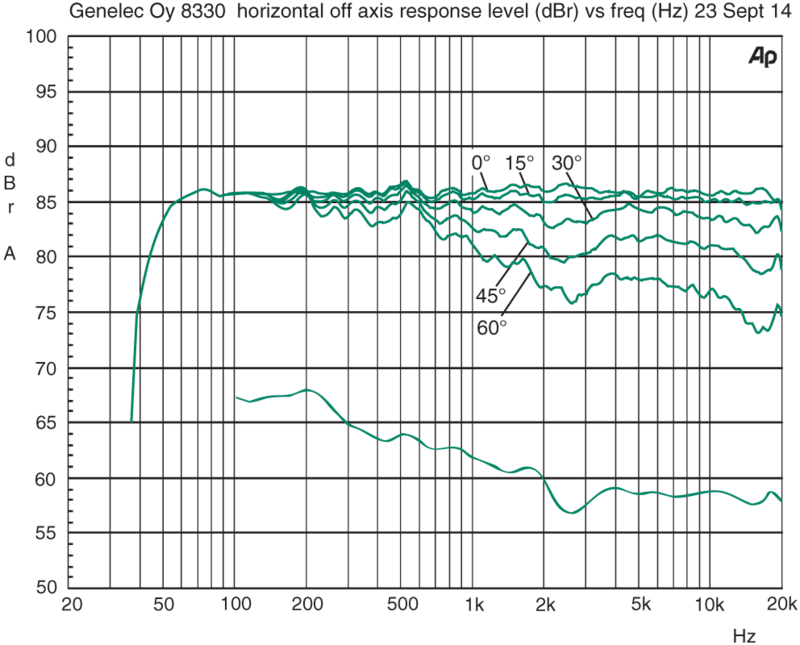
SPL
SPL pico Máximo pico de Salida Acústica por par, encima de consola a 1 metro de distancia con reproducción de material musical.
≥110 dB
SPL máximo a corto plazo Max. salida acústica de onda sinusoidal a corto plazo en axis en medio espacio, promedio desde 100 Hz to 3 kHz, a 1m de distancia.
≥104 dB
Máximo SPL a largo plazo Máxima salida acústica RMS a largo plazo en las mismas condiciones con ruido ponderado IEC (limitado por el circuito de protección de la unidad del controlador) a 1 m. .
≥96 dB
Ruido propio
Ruido propio Nivel de Ruido Inherente en campo abierto a 1 Metro en Axis
≤5 dB SPL
Peso
Peso5.1 kg (11.2 lb)
Dimensiones
Altura
285 mm
Altura con Iso-Pod
299 mm
Anchura
189 mm
Profundidad
178 mm
Alto 230mm Alto con Iso-Pod 242 mm Ancho 151mm Profundidad 142mm
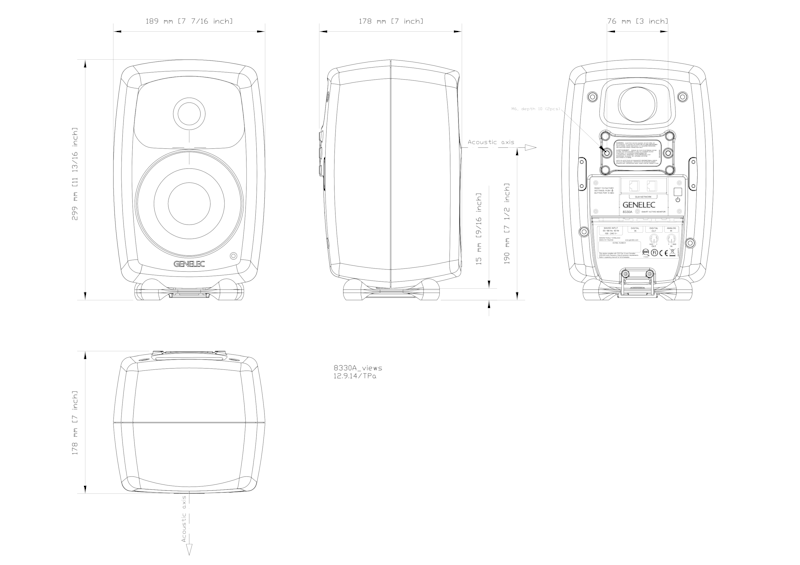
Recinto
Material del recinto
Die cast aluminium
Tipo de recinto
Reflex port
Altavoces
Tipo de altavoz
Cone
Diámetro
130 mm
Tipo de altavoz
Metal dome
Diámetro
19 mm
Directividad
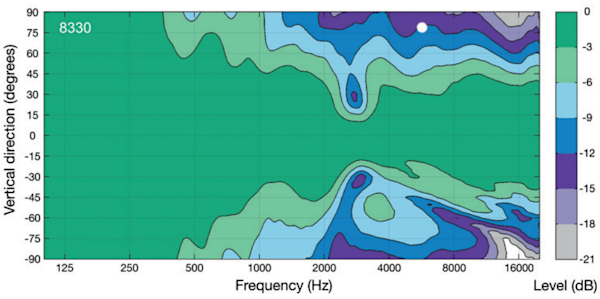
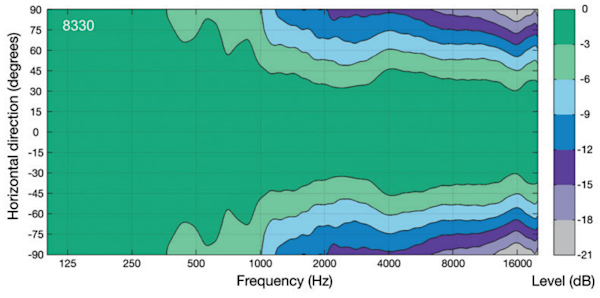
Distorsión armónica
100 Hz ≤0.5 %
Retardo de grupo
La latencia a altas frecuencias desde la entrada hasta la salida acústica, medida en la entrada análoga:
Extended Phase Linearity in GLM set to OFF (top
graph)
Linealidad de fase extendida en GLM configurada en APAGADO (grafica superior)
En los gráficos de rendimiento de Genelec, el tiempo de conversión de la señal de entrada electrónica a la salida acústica en un monitor Genelec es descrito por dos factores: latencia y Retardo de Grupo. El factor de retardo de grupo se puede leer en los gráficos para una frecuencia específica. El total de el retardo de entrada a salida, específico de la frecuencia es una suma
de los factores de latencia y retardo de grupo.
Para entender el significado de este retraso total,
considere que alejar un altavoz a 1 metro crea un retraso adicional de unos 3 ms.
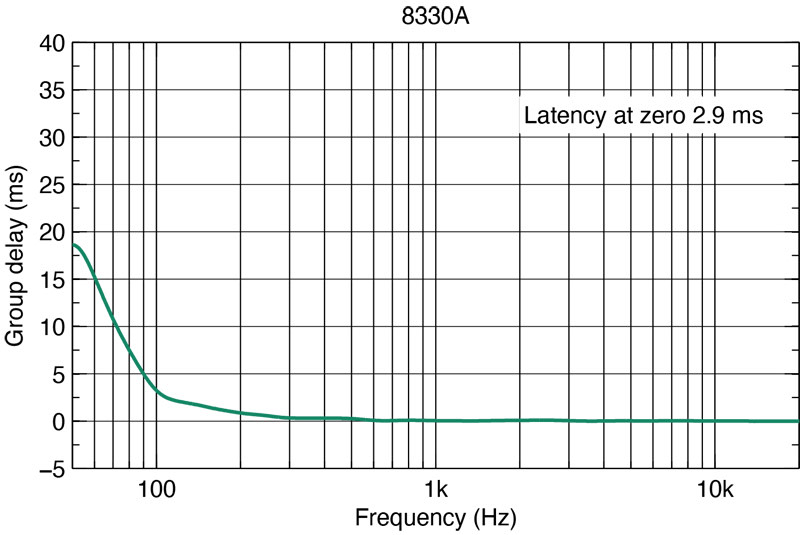
Sección de amplificación
Amplificadores
50 W Class D
50 W Class D
Voltaje de la toma eléctrica
100-240 VAC 50/60Hz
Consumo de potencia
Con ISS activo
≤0.5 W
En reposo
≤3 W
A pleno rendimiento
50 W
Sección de procesado de señal
Conectores
Input Analog signal input connector XLR female, balanced 10 kOhm.
Input XLR female IN
Output XLR male OUT
2 x Control Two CAT5 (RJ45) GLM Network connectors for computer control using the Genelec Loudspeaker Manager (GLM) software.
Filtro de cruce
Bajos/Agudos
Variantes de producto
Códigos de producto
Accesorios compatibles
Códigos de producto
Para más detalles técnicos consulte por favor el manual de operación del producto
Tecnologías clave

Smart Active Monitoring (SAM™) and GLM™ calibration technology

Directivity Control Waveguide (DCW™) Technology

Intelligent Signal Sensing (ISS™) Technology

Active Crossovers

Iso-Pod™ Stand

Optimised Amplifiers

Protection Circuitry

Reflex Port Design

Versatile Mountings

Minimum Diffraction Enclosure (MDE™) Technology
Networked Smart Active Monitor (SAM™) Systems feature automatic calibration to the environment.

Now, more than ever, audio productions are engineered in tighter, more confined working environments. This increases acoustic problems and lowers the reliability of monitoring. At the same time, an audio engineer's need to trust a reliable and precise monitoring system that reproduces sound neutrally and without distortion has not changed.
Built upon the solid electro-acoustic foundations of our 1200, 8000 and 7000 Series products, Genelec SAM Systems are today’s most advanced and flexible monitoring solutions. They are an indispensable tool for audio professionals, as they automatically adapt to the acoustic environment and correct for level, delay and room anomalies. SAM Systems are controlled using Genelec's proprietary Loudspeaker Manager (GLM™) network and software, enabling you to build a highly flexible and reliable monitoring system.
GLM is a highly intuitive and powerful monitor control networking system that manages connectivity to all SAM studio monitors and subwoofers on the network. GLM software features adjustment of level, distance delay and flexible room response compensation equalisation with our state-of-the-art, highly robust AutoCal™ 2 algorithm automated calibration system. All parameters and settings are stored in system setup files or saved in each individual monitor or subwoofer, if the GLM network needs to be disconnected.
Also, all acoustical features of SAM Systems can be optimised and tailored for different working styles or client demands. Additionally, even if the monitors or the production projects move between rooms, you can expect SAM technology to provide the highest consistency in monitoring, providing neutral soundstage imaging with low distortion – in each environment.
Genelec SAM Systems offer a comprehensive, solution-oriented, intelligently networked product range supporting analogue and digital signals in virtually any working environment.
Directivity Control Waveguide (DCW™) for flat on and off-axis response.

A revolutionary approach was taken by Genelec in 1983 with the development of its Directivity Control Waveguide (DCW™). We have developed and refined this technology over more than 30 years to greatly improve the performance of direct radiating multi-way monitors.
The DCW technology shapes the emitted wavefront in a controlled way, allowing predictable tailoring of the directivity (dispersion) pattern. To make the directivity uniform and smooth, the goal is to limit the radiation angle so that the stray radiation is reduced. It results in excellent flatness of the overall frequency response as well as uniform power response. This minimises early reflections and provides a wide and controlled listening area achieving accurate sound reproduction on and off-axis.
Minimised early reflections and controlled, constant directivity have another important advantage: the frequency balance of the room reverberation field is essentially the same as the direct field from the monitors. As a consequence, the monitoring system's performance is less dependent on room acoustic characteristics.
Sound image width and depth, critical components in any listening environment, are important not only for on-axis listening, but also off-axis. This accommodates not only the engineer doing their job, but also others in the listening field, as is so often the case in large control rooms.
DCW™ Technology key benefits:
- Flat on and off-axis response for wider usable listening area.
- Increased direct-to-reflected sound ratio for reduced control room coloration.
- Improved stereo and sound stage imaging.
- Increased drive unit sensitivity up to 6 dB.
- Increased system maximum sound pressure level capacity.
- Decreased drive unit distortion.
- Reduced cabinet edge diffraction.
- Reduced complete system distortion.
Intelligent Signal Sensing (ISS™) for power consumption reduction in stand-by mode.

Introduced early 2013, Genelec’s Intelligent Signal-Sensing technology has been developed to meet with both European Union ErP Directives and Genelec's own ambitious sustainability standards.
The Intelligent Signal Sensing, ISS™ circuitry tracks the signal input of the loudspeaker and detects if it is in use. If the ISS circuit does not find any audio on the input for a period of time, it sets the loudspeaker to a low-power sleep state and the loudspeaker will consume less than 0.5 watts. When an input signal is detected, the loudspeaker immediately turns itself on.
Additionally an ‘ISS Disable’ switch is located on each product’s back plate next to the other room response controls. First, when the mains power switch of the loudspeaker is set to 'ON', the ISS™ auto-start function (low-power sleep state on/off) of the loudspeaker is active.

If this function is not desired, the ISS™ function can be disabled by setting the 'ISS Disable' switch on the back panel to 'ON' position. In this mode, the monitor is only powered on and off using the mains power switch.
Note that the mains power switch will always turn the monitor off completely.
Active crossover operating at low signal levels.

Audio electronic crossovers allow the audio signal to be split into separate frequency bands that are separately routed to individual power amplifiers, which are then connected to specific transducers optimised for a particular frequency band.
Active crossovers come in both digital and analogue varieties. Genelec digital active crossovers include additional signal processing, such as driver protection, delay, and equalisation.
Genelec analogue active crossover filters contain electronic components that are operated at low signal levels suitable for power amplifier inputs. This is in contrast to passive crossovers that operate at the high signal levels of the power amplifier's outputs, having to handle high currents and, in some cases, high voltages.
In a typical two-way system the active crossover needs two power amplifiers — one for the woofer and one for the tweeter.
The active crossover design offers multiple benefits:
- The frequency response becomes independent of any dynamic changes in the driver's electrical characteristics or the drive level.
- There is increased flexibility and precision for adjusting and fine-tuning each output frequency response for the specific drivers used.
- Each driver has its own signal processing and power amplifier. This isolates each driver from the drive signals handled by the other drivers, reducing inter-modulation distortion and overdriving problems.
- The ability to compensate for sensitivity variations between drivers.
- The possibility to compensate for frequency and phase response anomalies associated with a driver’s characteristics within the intended pass-band.
- The flat frequency response of a high-quality active loudspeaker is a result of the combined effect of the crossover filter response, power amplifier responses and driver responses in a loudspeaker enclosure.
Using the active approach enables frequency response adjustments and optimisation of the full loudspeaker system, placed in various room environments, without expensive external equalisers. The end result is a simpler, more reliable, efficient, consistent and precise active loudspeaker system.
Vibration decoupling Iso-Pod™ stand improves sound image definition.

Although it is advisable to use sturdy and stable floor stands together with free-standing loudspeakers, a very common solution is to place loudspeakers directly on a table or on a console meter bridge.
This causes several detrimental side effects. Aiming of the loudspeaker axis towards the listener is rarely implemented, also, unwanted mechanical vibration do propagate from the loudspeaker to the mounting surface, and first order reflection on the work surface causes comb filtering and hence ripples in the frequency response.
To solve these very common problems Genelec developed an efficient and very practical solution. We designed a loudspeaker stand called Iso-Pod™ - Isolation Positioner/Decoupler that is attached to the aluminium enclosure. It has four shallow feet and it is made from special lossy rubber-like material. It is firmly attached to the enclosure so that it can be slid along the curved bottom or side surface to allow for a ±15° tilt of the loudspeaker.
The loudspeakers’ acoustical axis can then be pointed precisely towards the listener by adjusting the enclosure’s inclination with the Iso-Pod. The vibration isolation and damping properties reduce midrange coloration caused by unwanted vibration transmitted to supporting surfaces.
This innovative solution is an integral part of Genelec loudspeaker design and provides clear benefits in usability and sound quality.
Each transducer is driven by its own optimised amplifier.

Audio electronic crossovers allow to split the audio signal into separate frequency bands that can be separately routed to individual power amplifiers, which are then connected to specific transducers optimised for a particular frequency band.
In a typical 2-way loudspeaker system, the active crossover needs two power amplifiers — one for the woofer and one for the tweeter. The power amplifiers are connected directly to the drivers of an active loudspeaker, resulting in the power amplifier’s load becoming much simpler and well known. Each driver-specific power amplifier has only a limited frequency range to amplify (the power amplifier is placed after the active crossover) and this adds to the ease of design.
The active design principle offers multiple benefits:
- The power amplifiers are directly connected to the speaker drivers, maximising the control exerted by the power amplifier’s damping on the driver’s voice coil, reducing the consequences of dynamic changes in the driver electrical characteristics. This may improve the transient response of the system.
- There is a reduction in the power amplifier output requirement. With no energy lost in the passive crossover filter components, the amplifier power output requirements are reduced considerably (by up to 1/2 in some cases) without any reduction in the acoustic power output of the loudspeaker system. This can reduce costs and increase audio quality and system reliability.
- No loss between amplifier and driver units results in maximum acoustic efficiency.
- Active technology can achieve superior sound output vs. size vs. low frequency cut-off performance.
- All loudspeakers are delivered as a factory aligned system (amplifiers, crossover electronics and enclosure-driver systems).
Sophisticated drive unit protection circuitry for safe operation.

When working in critical audio production environments it is essential that monitoring systems remain reliable and functional at all times. One of the main reasons behind Genelec’s excellent success in broadcasting environments is the reliability of our products and a key element behind the reliability is the internal protection circuitry found in all products since 1978.
The protection circuitry prevents driver failures by detecting signal levels, and in case of sudden peaks or constantly too high levels, taking the signal level down automatically. Of course this feature does not affect the sound quality in any way when working within the specifications of the loudspeaker, but only prevents inadequate input signals from breaking the loudspeaker.

Protection circuitry features and benefits:
- Reduces the output level when required, (e.g. when driver voice coil temperature reaches the safe limit), which highly improves system reliability.
- Appropriate protection circuitry design in every loudspeaker and subwoofer enables the maximisation of system output sound level.
Advanced reflex port design for extended low frequency response.

Genelec’s choice for vented, or reflex, enclosures dates back to the S30 model, the first Genelec product from 1978. Port performance has been improved and refined over the years with the aim to increase the woofer’s low frequency extension and sound pressure level capability to provide outstanding bass articulation and definition.
Both driver and vent contribute to the total radiation of a reflex enclosure. Most radiation comes from the driver, but at the vent-enclosure resonant frequency the driver displacement amplitude is small and most of the radiation comes out of the vent.
To minimise the air speed in the tube, the cross sectional area of the vent should be large. This in turn means that the vent tube has to be long which presents quite a design challenge.
The long, curved tube maximises airflow so deep bass can be reproduced without compression. The reflex tube terminates with a wide flare located on the rear of the enclosure, minimising port noises and providing excellent bass articulation.
The curvature of the tube has also been carefully designed to minimise any audible noise, compression or distortion. The inner end of the tube has proper resistive termination to minimise once again audible chuffing noise and air turbulence.
Proper reflex port design allows also to significantly reduce the woofer’s displacement, improving the linear low frequency output capacity.
Versatile mounting options for all installation needs.

In addition to perfect acoustical design and advanced tailoring options to optimize the loudspeaker’s behaviour to the room environment, Genelec loudspeakers offer a variety of mounting options for easy installation in different applications.
Our wide range of accessories and fixed mounting points on the back of our aluminium enclosure products offer solutions to all common installation situations. M6 support points have been integrated in the die-cast enclosure for wall and ceiling mounts.
Some models also feature a 3/8” thread at the bottom of the enclosure to fit a robust microphone stand. Other larger and heavier models feature M10 fixing points. Special floor stand plates have been designed in order to fit the Iso-Pod stand that is part of our product design.
With these features our loudspeakers have found their way to a variety of applications beyond the professional audio and studio world, for example in commercial and AV installation projects as well as in home environments all around the world.
Minimum Diffraction Enclosure (MDE™) for uncoloured sound reproduction.

A common problem with standard free-standing loudspeakers is that the front baffle discontinuities cause diffractions and the loudspeaker sharp corners act as secondary sources through reflections.
In order to improve the flatness of the frequency response and the power response of free standing loudspeaker systems, Genelec have designed a highly innovative enclosure optimized to match the properties of the monitor drivers, featuring rounded edges, and gently curved front and sides. In addition to achieving an unsurpassed flatness of the frequency response, the enclosure having minimum diffractions yields superb sound stage imaging qualities.
To achieve such a smooth and elegantly curved cabinet surface and to reduce the outer dimensions of the enclosure, maximising at the same time the internal volume for improved low frequency efficiency, we designed a cabinet made off die-cast aluminium. Aluminium is lightweight, stiff and very easy to damp to yield a “dead” structure. The cabinet walls can be made fairly thin, providing at the same time good EMC shielding and excellent heat sink for the power amplifiers. Die-casting is made in two parts, front and rear, and they are easy to separate for potential servicing needs.
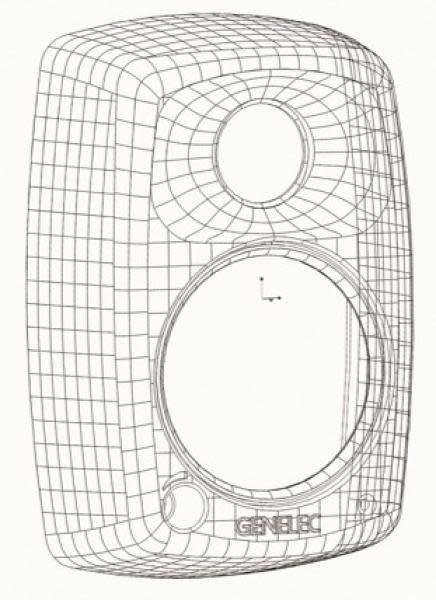
The DCW waveguide has been integrated in the MDE aluminium enclosure to provide improved control of the loudspeaker’s directivity. Basically, the low frequency limit for constant directivity is determined by the size of the waveguide, so the larger the surface the better the control. With a very controlled off-axis radiation, the listening window becomes consistent, which is of utmost importance with multi-channel audio monitoring. Controlled directivity also reduces possible first order reflections on surfaces near the loudspeaker, helping to provide consistent audio reproduction in different acoustical environments. In fact, the entire front baffle is gently curved and the acoustically transparent grilles are part of the outer cabinet aesthetics, blending perfectly with the various other curved surfaces.

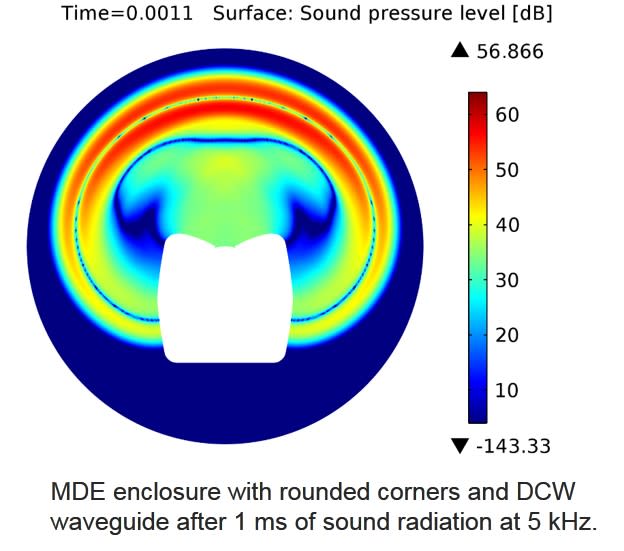
Referencias
Genelec UNIO Explained | How the ecosystem offers seamless in-room and personal headphone monitoring
Jonna Tervomaa interview - The Art of Creating in Your Space
Usando GLM | Tutorial
Using GLM | The foundations
Using GLM | Controlling GLM with MIDI
Using GLM | GRADE Room Acoustic Report
Using GLM | Calibration Group IDs
Using GLM | Accounts and product registration
Using GLM | The technical details
Genelec UNIO Explained | How the ecosystem offers seamless in-room and personal headphone monitoring
A quick guide to our UNIO Ecosystem – which offers audio engineers seamless bridging of in-room and personal headphone monitoring. https://genelec.com/UNIO
The Genelec UNIO Ecosystem – which combines the power of our renowned GLM, SAM Monitoring and Aural ID adaptive technologies – gives audio engineers the flexibility to work anywhere, anytime, from stereo to immersive. And now, with the new UNIO Personal Reference Monitoring (PRM) solution, audio professionals benefit from the pinpoint accuracy of our pioneering active monitoring headphone solution, which combines the 9320A SAM Reference Controller with uniquely factory-calibrated 8550A Professional Reference Headphones.
To learn more, visit https://genelec.com/UNIO
Jonna Tervomaa interview - The Art of Creating in Your Space
Long-time legend of Finnish pop culture, Jonna Tervomaa, reveals the secrets of her creative process.
After first rising to musical fame in 1983 at the age of ten, Jonna began her illustrious career in earnest with her self-titled debut album released in 1998, going on to win seven Emma Gala Music Awards - the Finnish equivalent of Grammy Awards.
Her music has proven consistently popular in her native land of Finland, earning her chart success, plus platinum and gold sales.
Although mostly known for her evergreen hits ‘Suljettu Sydän’ (Closed Heart) and ‘Yhtä En Saa’ (I Won’t Get A Single One), Jonna has a diverse catalogue of fresh treasures to explore, including her first entirely English language album called ‘Fortunate Beast’.
Jonna’s creative space is powered by Genelec 8330A RAW monitors and a GLM Kit.
Discover more about Jonna on our website, click here
"The latest monitors in Genelec’s 8 series come in new APM packs, with room analysis and correction tools. We put them to the test."
-Bob Thomas, the author of the review article
{"fi-FI":"Sound on Sound Magazine's review of 8320 and 8330 studio monitors. The review was published in May 2015, and it is written by Bob Thomas.","ru-RU":"Sound on Sound Magazine's review of 8320 and 8330 studio monitors. The review was published in May 2015, and it is written by Bob Thomas.","de-DE":"Sound on Sound Magazine's review of 8320 and 8330 studio monitors. The review was published in May 2015, and it is written by Bob Thomas.","en-US":"Sound on Sound Magazine's review of 8320 and 8330 studio monitors. The review was published in May 2015, and it is written by Bob Thomas.","sv-SE":"Sound on Sound Magazine's review of 8320 and 8330 studio monitors. The review was published in May 2015, and it is written by Bob Thomas.","es-ES":"Sound on Sound Magazine's review of 8320 and 8330 studio monitors. The review was published in May 2015, and it is written by Bob Thomas."}
Encuentra tu representante

Documentación
Documentos
Operating Manual 8330A Brochure 8330A SAM™ Series Full Line Catalogue In-Room Product Performance Immersive Solutions Brochure Genelec Home Studio Audio Monitoring Guide (2023) Operating Manual 8320 & 8330 - Chinese Version Genelec Home Studio Audio Monitoring Guide (German version)Descargas
Line Drawings (PDF) 8330A Line Drawings (DWG) 8330A 8330A - Simulation File (EASE3) 8330A - Simulation File (EASE4) 8330A - Simulation File (CLF)Preguntas frecuentes
There are several improvements in the new 83xx products. The capability to adapt to the room acoustics has been improved greatly, and, for example, 8320 and 8330 products provide four to five times higher number of tools for room response compensation compared to the 82xx products. The delay alignment capability has been expanded from about 80 ms to about 200 ms in 83xx. 83xx have been time-equalized internally to have a constant input-to-output delay above 400 Hz. 83xx products can level align by 60 dB.
All 83xx and 73xx products support distributed bass management, enabling the audio signal to be passed unmodified from the source and through the subwoofer into the monitors. 73xx subwoofers support a multichannel analogue audio signal and stereo AES/EBU digital audio signal.
"The latest monitors in Genelec’s 8 series come in new APM packs, with room analysis and correction tools. We put them to the test."
-Bob Thomas, the author of the review article
Sound on Sound Magazine's review of 8320 and 8330 studio monitors. The review was published in May 2015, and it is written by Bob Thomas.
hello

